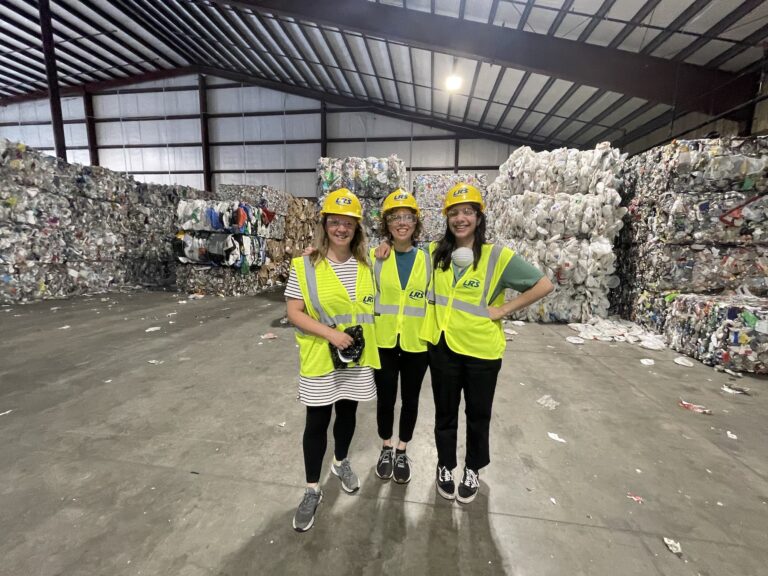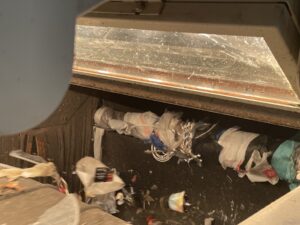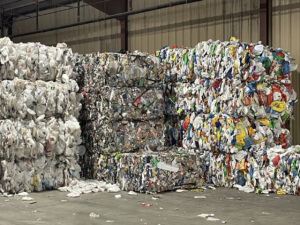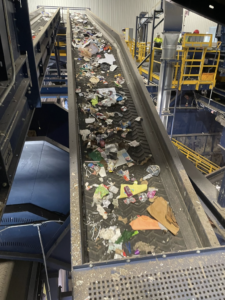
Recently, SGA’s Zero Waste Schools (ZWS) staff had a behind-the-scenes tour of Lakeshore Recycling Services’s (LRS) Exchange Material Recovery Facility (MRF). An MRF is a facility that sorts, cleans, and packages materials that are then sold to be made into new materials. SGA was fortunate to have Joy Rifkin, LRS’s sustainability Manager, educate us about the recycling process and the workings of a recovery facility. In addition to our informative discussion, Joy provided a tour of the facility which highlighted important technology and machinery being utilized at the MRF.
 We learned that what can be recycled depends on the technology being utilized at a facility. LRS uses optical sorting machines that use lights and sensors to separate materials using small puffs of air. The air allows the machine to separate the different materials at an incredibly fast rate. During the tour we noticed plastic film caught in the sorting machine. Contamination like plastic film (camera film, plastic bags, etc.) cause machines to get clogged and halts sorting at the facility. Check out these resources for plastic film and bag recycling drop off locations. We also learned that sorters can more easily detect material types if items are 3-dimensional vs. 2-dimensional, so cans and bottles should not be crushed.
We learned that what can be recycled depends on the technology being utilized at a facility. LRS uses optical sorting machines that use lights and sensors to separate materials using small puffs of air. The air allows the machine to separate the different materials at an incredibly fast rate. During the tour we noticed plastic film caught in the sorting machine. Contamination like plastic film (camera film, plastic bags, etc.) cause machines to get clogged and halts sorting at the facility. Check out these resources for plastic film and bag recycling drop off locations. We also learned that sorters can more easily detect material types if items are 3-dimensional vs. 2-dimensional, so cans and bottles should not be crushed.
In addition to optical sorting machines, magnets play a vital role in separating metal from other materials. LRS’s MRF uses magnetism to capture any cans or other metal materials containing iron. Another machine uses repulsion, or eddy currents, to capture non-ferrous metal, items that don’t contain iron.
While LRS employs a variety of technology in the sorting process, the facility still relies on workers to hand sort items that the machines might miss. Recycling requires a lot of energy and effort, as LRS runs two 10-hour recycling shifts each day. Reducing contamination in your home recycling can help limit complications at the recycling facility and keep the process running smoothly. Our visit to LRS’s new MRF was eye-opening and revealed why it is so important to properly sort recyclables. More importantly, it solidified our commitment to the idea that the best way to manage waste is to not create it in the first place.

Resources:
LRS’s website has extensive resources, including signage, an interactive map that shows where different items go after the MRF, and a virtual tour of the MRF.
Below are additional resources for counties surrounding Chicago:
- – Northern Cook County: SWANCC’s online recycling directory offers information on where to recycle hard to recycle items and answers frequently asked questions about recycling electronics, appliances, plastic bags, and much more.
- – Lake County: SCARCE offers a reuse center for members of Lake County as well as recycling events.
- – DuPage County: For residents in DuPage County, SWALCO’s recycling guideline offers an extensive interactive guide to help eliminate contamination within recycling.
- – The City of Chicago also provides resources for recycling such as a household guide, an interactive quiz, and a schedule of specific recycling events for hard to recycle items.
 LRS’s recycling best practices:
LRS’s recycling best practices:
- – Materials should be loose in the recycling cart (no bags)
- – For recycling plastic make sure that your items are hard plastic items such as tubs and jugs and that the items are larger than a fist
- – Paper coffee cups are now being accepted for recycling
- – Items should be empty and clean; however items do not need to be 100% clean to be recycled . MRF’s typically wash items during the sorting and packing process.
- – Plastic caps and lids should be placed on the original container
- – Flatten boxes
- – NO plastics bags, dirty kleenex, PPE, or food soiled pizza boxes
